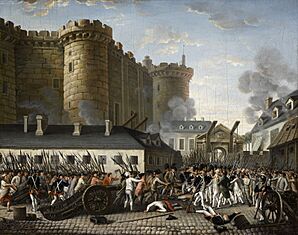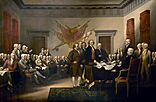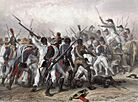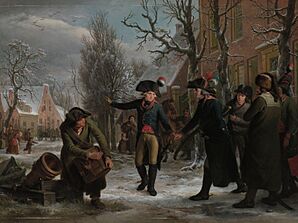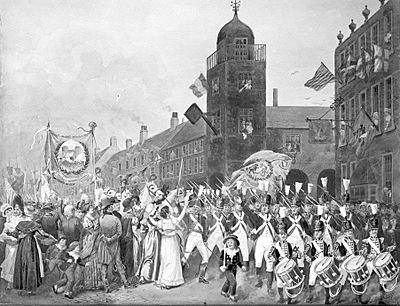Atlantic Revolutions facts for kids
Quick facts for kids Atlantic Revolutions |
|
|---|---|
| Part of the Age of Revolution | |
|
Clockwise from top:
|
|
| Date | 22 March 1765 – 4 December 1838 (73 years, 8 months, 1 week and 5 days) |
| Location |
Atlantic World
|
| Caused by | |
| Resulted in | Multiple revolutions and wars across the Atlantic world, including the American Revolutionary War, French Revolutionary and Napoleonic Wars, and the Spanish American wars of independence |
The Atlantic Revolutions (1765–1838) were a series of big changes and wars. They happened around the Atlantic Ocean in the late 1700s and early 1800s. During this time, new ideas from the Age of Enlightenment became popular. These ideas questioned the power of kings and queens who ruled absolutely.
People wanted to end rule by monarchs and spread ideas about freedom and rights for everyone. They believed in the importance of individual liberty. Some revolutions in West Africa also pushed for different forms of Islam that were more equal.
Early signs of these changes appeared in 1755 with the Corsican Republic and Pontiac's War. The biggest early revolution was the American Revolution in 1765. This led to the creation of the United States of America. The American Revolution inspired other movements. These included the French Revolution in 1789 and the Haitian Revolution in 1791.
These revolutions were based on the idea that personal freedom was linked to the right to own property. This concept was spread by thinkers like Edmund Burke. They also believed in the equality of all men. This idea was written into the new laws and constitutions that came from these revolutions.
Contents
History of Atlantic Revolutions
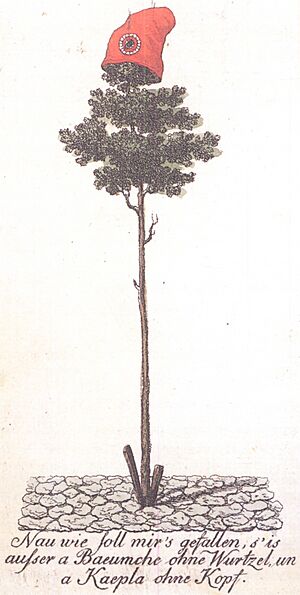
These revolutions happened in both the Americas and Europe. Key places included the United States (1765–1783) and France (1789–1814). Other important areas were Haiti (1791–1804) and Spanish America (1810–1825). There were also smaller uprisings in places like Switzerland and Brazil.
People involved in these revolutions often knew about each other's struggles. They were inspired by or copied ideas from other movements.
The American Revolution (1765–1783) was the start of independence movements in the New World. France, the Netherlands, and Spain helped the new United States gain freedom from Britain. In the 1790s, the Haitian Revolution began, leading to Haiti's independence. As Spain was busy with wars in Europe, its colonies in mainland America also gained independence around 1820.
Over time, these revolutions were largely successful. They spread important ideas like liberalism (freedom and rights) and republicanism (rule by the people). They helped to overthrow powerful nobles, kings, and old church systems.
These movements highlighted the universal ideas of the Age of Enlightenment. These included the idea that all people are equal. They also pushed for fair justice under the law, decided by unbiased courts. This was different from justice given out by a local noble's whim. The revolutions showed that creating a completely new government could actually work. This led to a "revolutionary mindset" that still exists today.
The ideas of the Atlantic Revolutions were sometimes complex. For example, Edmund Burke supported the American colonists in 1774. He felt their property and rights were being taken away unfairly by the king. However, Burke criticized the French Revolution in 1790. He believed the French revolutionaries were taking away property, traditions, and religious rights too quickly. In both cases, Burke followed the idea that owning property is key to personal freedom.
The American Revolution was a major event in this period. It led to the United States becoming an independent country. Its impact spread across the Atlantic, influencing other movements in Europe and the Americas. For example, the Haitian Revolution in the 1790s challenged colonial rule. It inspired hopes for freedom and equality. Similarly, Spanish colonies in the Americas gained independence around 1820.
These revolutions were connected and driven by ideas of freedom and self-governance. They aimed to remove old systems of power and create governments based on Enlightenment principles. This revolutionary spirit showed that new governments based on justice and equality were possible.
Major National Revolutions
Many different revolutions took place during this period:
- Corsican Revolution (1755–1769)
- Pontiac's War (1763–1766)
- American Revolution (1765–1783)
- Geneva Revolution (1782)
- Northwest Indian War (1785–1795)
- Revolt of Dutch Patriots (1785)
- French Revolution (1789–1799)
- Liège Revolution (1789–1795)
- Brabant Revolution (1790)
- Haitian Revolution (1791–1804)
- Minor slave revolts in the British Virgin Islands (1790, 1823, 1830)
- Polish War in the Defence of Constitution (1792) and Kościuszko Uprising (1794)
- Stäfner Handel in Canton of Zürich, Switzerland (1794–1795)
- Batavian Revolution (1795)
- Slave revolt in Curaçao (1795)
- Bush War, Saint Lucia (1795)
- Fédon's rebellion, Grenada (1796)
- Second Maroon War, Jamaica (1795–1796)
- Second Carib War, Saint Vincent (1795–1797)
- Scottish Rebellion (1797)
- United Irish Rebellion (1798)
- Helvetic Revolution (1798)
- Altamuran Revolution (1799)
- Serbian Revolution (1804–1835)
- Fula jihads in West Africa, leading to new states (e.g., Fulani Jihad (1804–1808) establishing the Sokoto Caliphate)
- 1811 German Coast uprising (1811, Louisiana)
- Norwegian War of Independence (1814)
- Liberal Revolution of 1820 (1820, Portugal)
- Decembrist revolt (1825) and Chernigov Regiment revolt (1825–1826)
- Upper and Lower Canada Rebellions (1837–1838)
- Latin American wars of independence
- Brazilian revolutionary movements
- Minas Conspiracy in Minas Gerais, Brazil (1789)
- Bahian Revolt (Conjuração Baiana) in Bahia, Brazil (1798)
- Pernambucan Revolt in Pernambuco, Brazil (1817)
- War of Independence of Brazil (1821–1824)
- José Leonardo Chirino's Insurrection, Venezuela (1795)
- Spanish American wars of independence (1808–1833)
- Argentine War of Independence
- May Revolution (Argentina and nearby countries, 1810)
- Oriental Revolution (Uruguay, 1811)
- Chilean War of Independence
- Peruvian War of Independence
- Bolivian War of Independence
- Military career of Simón Bolívar (Northern and Western South America)
- Ecuadorian War of Independence
- Patria Boba (Colombia)
- Venezuelan War of Independence
- Mexican War of Independence (1810–1821)
- Argentine War of Independence
- Brazilian revolutionary movements
These different uprisings shared many common ideas. They focused on the "Rights of Man" and individual freedom. They also believed in "popular sovereignty," meaning that power comes from the people. This idea was often based on the writings of John Locke or Jean-Jacques Rousseau.
Many revolutionaries believed in a "social contract"—an agreement between the government and the people. This was often written down in new constitutions. They also shared certain religious beliefs, often linked to deism, which valued reason. They strongly disliked feudalism (an old system of land ownership) and often disliked monarchy (rule by kings) itself.
The Atlantic Revolutions also used many similar symbols. These included the name "Patriot" for revolutionary groups and the slogan "Liberty". Other symbols were the liberty cap, Lady Liberty, and the tree of liberty.
Important People and Groups
- George Washington (United States)
- John Adams (United States)
- Thomas Jefferson (United States)
- Alexander Hamilton (United States)
- Benjamin Franklin (United States)
- Sons of Liberty (North America)
- Maximilien Robespierre (France)
- Marquis de Lafayette (France and North America)
- Georges Danton (France)
- Napoleon Bonaparte (France and most of Europe)
- Jacobin Club (France, 1789–1794)
- Société des Amis des Noirs (France)
- Patriots (Netherlands)
- Richard Price and Joseph Priestley (Great Britain)
- Thomas Paine (Great Britain and North America)
- Society of the Friends of the People (Great Britain, 1792-)
- London Corresponding Society (Great Britain)
- Society of the United Scotsmen (Scotland)
- Nore mutiny (Great Britain)
- Society of the United Englishmen
- Wolfe Tone (Ireland)
- Society of United Irishmen (Ireland, 1791–1804)
- Lautaro Lodge
- Pasquale Paoli (Corsica)
- Usman Dan Fodio (West Africa)
- Charles Deslondes (German Coast)
- Francisco de Miranda
- Société des Fils de la Liberté (Canada)
- Louis-Joseph Papineau (Canada)
- William Lyon Mackenzie (Canada)
- Samuel Lount (Canada)
- John Lambton 1st Earl of Durham (Canada, United Kingdom)
- Tadeusz Kościuszko (United States, Poland-Lithuania)
- Toussaint Louverture (Haiti)
- Inconfidência Mineira (Brazil, 1789)
- Conjuração baiana (Brazil, 1798)
- Simón Bolívar (Venezuela, Colombia, Ecuador, Peru, Bolivia)
- José de San Martín (Argentina, Chile, Peru)
- José Gervasio Artigas (Uruguay, Argentina)
- José María Morelos (Mexico)
- Miguel Hidalgo y Costilla (Mexico)
- Agustín de Iturbide (Mexico)
- Vicente Guerrero (Mexico)
- Jørgen Jørgensen (Iceland)
- Age of Revolution
See Also
- Age of Revolution
- Atlantic history, on historiography
- Atlantic World
- Piracy in the Atlantic World
- Revolutions of 1848


